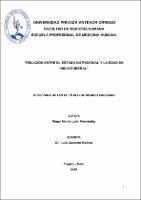| dc.contributor.advisor | Zavaleta Medina, Luis | |
| dc.contributor.author | Leon Fernandez, Roger Martin | |
| dc.creator | Leon Fernandez, Roger Martin | |
| dc.date.accessioned | 2017-05-16T22:40:15Z | |
| dc.date.available | 2017-05-16T22:40:15Z | |
| dc.date.issued | 2017 | |
| dc.identifier.uri | https://hdl.handle.net/20.500.12759/2639 | |
| dc.description.abstract | OBJETIVO: El presente estudio determinó la relación entre el estado nutricional y la edad de
inicio puberal en niños y niñas entre 8 a 12 años, atendidos en el Policlínico El Porvenir en el
periodo setiembre-diciembre 2015.
MATERIAL Y MÉTODOS: Se realizó un estudio observacional, transversal analítico en el
Policlínico El Porvenir, en el periodo setiembre – diciembre 2015, donde se evaluaron 223
pacientes, de los cuales solo ingresaron al estudio 196, siendo 142 mujeres y 54 varones. Para
la evaluación del estado nutricional se utilizó la formula antropométrica del índice de masa
corporal (IMC) y para el estadiaje Tanner, se usó la inspección y palpación en las niñas y el
orquidómetro para los niños. Para la confección de las tablas se utilizó estadística descriptiva y
ANOVA de un factor.
RESULTADOS: Se pudo determinar según los patrones internacionales de crecimiento
infantil de la OMS, que de los 196 pacientes atendidos, 41.8% tuvieron peso normal, 35% se
encontró con sobrepeso y 22.9% tuvo obesidad, por tanto, el 59% de la población atendida se
encontró por encima de su peso normal para su edad. No hubo pacientes con bajo peso (<2DS).
El promedio de edad de las mujeres en Tanner II fue de 9, 7 años +- 8 meses y de hombres en
Tanner II fue 10,4 años +-8 meses. Al comparar la edad de inicio puberal por grupos de estado
nutricional en la población femenina, se evidenció que hubo diferencia estadísticamente
significativa (P=0.001) entre las mujeres de peso normal con las mujeres con sobrepeso y las
mujeres obesas. La relación entre el estado nutricional y la edad de inicio puberal en el grupo
masculino no fue significativa.
CONCLUSIONES: Se concluye que existe relación entre el estado nutricional y la edad de
inicio puberal en la población femenina del estudio, mas no en la masculina. Las pacientes con
mayor IMC (sobrepeso, obesidad) inician su desarrollo sexual de 7 meses a 1,6 años más
temprano que aquellas con peso normal. | es_PE |
| dc.description.abstract | OBJECTIVE: This study determined the relationship between nutritional status and age of
pubertal onset in children aged 8 to 12 years, treated at the Polyclinic El Porvenir in the period
september - december 2015.
MATERIALS AND METHODS: An analytical observational, cross-sectional study was
conducted at the Polyclinic El Porvenir , in the period September - December 2015, where 223
were evaluated, but only 196 were admitted. There were 142 women and 54 men. The
anthropometric formula for body mass index (BMI ) was used for the assessment of nutritional
status. Inspection and palpation in girls and orchidometer for boys were used for the Tanner
staging. Descriptive statistics and ANOVA of one factor was used for making tables
RESULTS: It could be determined by international child growth standards of WHO, that from
the 196 patients treated, 41.8 % were normal weight, 35 % were found overweight and 22.9 %
had obesity, therefore, 59% of the population served is found above normal weight for their age.
There were no patients underweight (< 2SD). The average age of women in Tanner II was 9, 7
years + - 8 months and men in Tanner II was 10.4 years + -8 months. When comparing the age
of pubertal onset by groups of nutritional status in the female population, it showed that there
was statistically significant difference (P = 0.001) among women of normal weight women with
overweight and obese women. The relationship between nutritional status and age of onset of
puberty in the male group was not significant.
CONCLUSIONS: It is concluded that there is a positive relationship between nuritional status
and age of puberal onset in the female population of the study, but not in men. Patients with
higher BMI (overweight, obesity) begin their sexual development from 7 months to 1,6 years
earlier tan those pacients eutrophic. | en_US |
| dc.description.uri | Tesis | es_PE |
| dc.format | application/pdf | es_PE |
| dc.language.iso | spa | es_PE |
| dc.publisher | Universidad Privada Antenor Orrego | es_PE |
| dc.relation.ispartofseries | T_MED.HUMA_2019 | |
| dc.rights | info:eu-repo/semantics/openAccess | es_PE |
| dc.rights.uri | https://creativecommons.org/licenses/by/4.0/ | es_PE |
| dc.source | Universidad Privada Antenor Orrego | es_PE |
| dc.source | Repositorio Institucional - UPAO | es_PE |
| dc.subject | Estado nutricional | es_PE |
| dc.subject | Índice de masa corporal | es_PE |
| dc.title | Relación entre el estado nutricional y la edad de inicio puberal | es_PE |
| dc.type | info:eu-repo/semantics/bachelorThesis | es_PE |
| thesis.degree.level | Título Profesional | es_PE |
| thesis.degree.grantor | Universidad Privada Antenor Orrego. Facultad de Medicina Humana | es_PE |
| thesis.degree.name | Médico Cirujano | es_PE |
| thesis.degree.discipline | Medicina Humana | es_PE |
| dc.subject.ocde | https://purl.org/pe-repo/ocde/ford#3.02.27 | es_PE |
| renati.type | https://purl.org/pe-repo/renati/type#tesis | es_PE |
| renati.level | https://purl.org/pe-repo/renati/level#tituloProfesional | es_PE |
| renati.discipline | 912016 | es_PE |
| dc.publisher.country | PE | es_PE |


